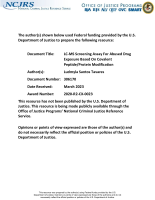MDMA (designer drug)
Toxicological Evaluation, Postmortem Case Descriptions, and Pharmacological Activity of N,N-dimethylpentylone and Related Analogs
Non-Contact Detection of Fentanyl and Other Opioids: Towards a Generalized Approach to Detection of Dangerous Drug Classes
Chromatographic and mass spectral studies on methoxymethcathinones related to 3,4-methylenedioxymethamphetamine
GC-MS Analysis of Acylated Derivatives of the Side Chain Regioisomers of 4-Methoxy-3-methyl-phenethylamines Related to Methylenedioxymethamphetamine
GC-IRD methods for the identification of some tertiary amines related to MDMA
GC-MS Studies on the Regioisomeric Methoxy-Methyl-Phenethylamines Related to MDEA MDMMA and MBDB
GC-MS and GC-IRD Analysis of Ring and Side Chain Regioisomers of Ethoxyphenethylamines Related to the Controlled Substances MDEA MDMMA and MBDB
The Detection of Novel Stimulants in Oral Fluid From Users Reporting Ecstasy, Molly and MDMA Ingestion
Centrifugal Microfluidic Devices Using Low-Volume Reagent Storage and Inward Fluid Displacement for Presumptive Drug Detection
Statistical Comparison of Mass Spectra for Identification of Amphetamine-type Stimulants
Analysis of amphetamine, methamphetamine, methylenedioxyamphetamine and methylenedioxymethamphetamine in whole blood using in-matrix ethyl chloroformate derivatization and automated headspace solid-phase microextraction followed by GC-MS
Synthetic Stimulant Market Rapidly Changing as N,N-Dimethylpentylone Replaces Eutylone in Drug Supply Typically Sold as "Ecstasy" or "Molly"
LC-MS Screening Assay For Abused Drug Exposure Based On Covalent Peptide/Protein Modification
Exposing School Employee Sexual Abuse and Misconduct: Shedding Light on a Sensitive Issue
Taking Stock: An Overview of NIJ's Reentry Research Portfolio and Assessing the Impact of the Pandemic on Reentry Research
Over several decades, the National Institute of Justice (NIJ) has made significant contributions to the field of reentry, specifically what works for whom and when. In recent years, however, the global pandemic has made it increasingly difficult to conduct research on and with populations involved with the justice system. During this time, many researchers assessing various justice-related outcomes were unable to continue their inquiries as planned due to a lack of access to their populations of interest, forcing many to pivot and rethink their research designs.
See the YouTube Terms of Service and Google Privacy Policy



